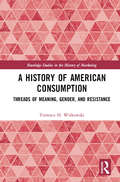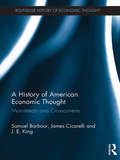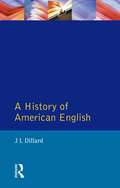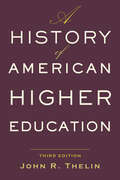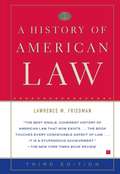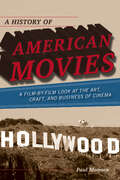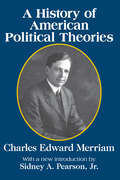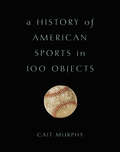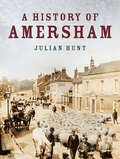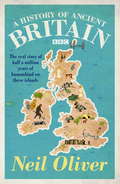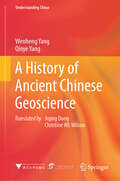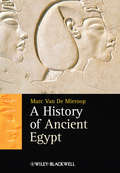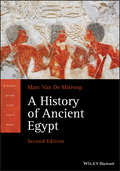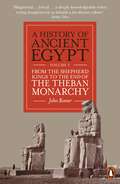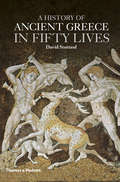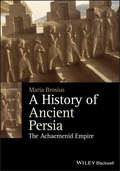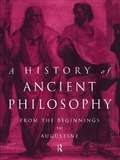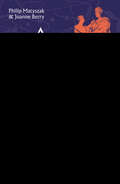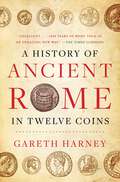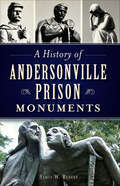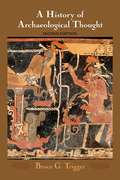- Table View
- List View
A History of American Consumption: Threads of Meaning, Gender, and Resistance (Routledge Studies in the History of Marketing)
by Terrence H. WitkowskiThe United States has been near the forefront of global consumption trends since the 1700s, and for the past century and more, Americans have been the world’s foremost consuming people. Informed and inspired by the literature from consumer culture theory, as well as drawing from numerous studies in social and cultural history, A History of American Consumption tells the story of the American consumer experience from the colonial era to the present, in three cultural threads. These threads recount the assignment of meaning to possessions and consumption, the gendered ideology and allocation of consumption roles, and resistance through anti-consumption thought and action. Brief but scholarly, this book provides a thought provoking, introduction to the topic of American consumption history informed by research in consumer culture theory. By examining and explaining the core phenomenon of product consumption and its meaning in the changing lives of Americans over time, it provides a valuable contribution to the literature on the subjects of consumption and its causes and consequences. Readable and insightful, it will be of interest to scholars and advanced students in consumer behaviour, advertising, and marketing and business history.
A History of American Economic Thought: Mainstream and Crosscurrents (The Routledge History of Economic Thought)
by Samuel Barbour James Cicarelli J. E. KingThis vital addition to the Routledge History of Economic Thought series surveys arguably the most important country in the development of economics as we know it today – the United States of America. A History of American Economic Thought is a comprehensive study of American economics as it has evolved over time, with several singularly unique features including: a thorough examination of the economics of American aboriginals prior to 1492; a detailed discussion of American economics as it has developed during the last fifty years; and a generous dose of non-mainstream American economics under the rubrics "Other Voices" and "Crosscurrents." It is far from being a native American community, and numerous social reformers and those with alternative points of view are given as much weight as the established figures who dominate the mainstream of the profession. Generous doses of American economic history are presented where appropriate to give context to the story of American economics as it proceeds through the ages, from seventeenth-century pre-independence into the twentieth-first century packed full of influential figures including John Bates Clark, Thorstein Veblen, Irving Fisher, Paul Samuelson, and John Kenneth Galbraith, to name but a few. This volume has something for everyone interested in the history of economic thought, the nexus of American economic thought and American economic history, the fusion of American economics and philosophy, and the history of science.
A History of American English (Longman Linguistics Library)
by J. L. DillardThis impressive volume provides a chronological, narrative account of the development of American English from its earliest origins to the present day.
A History of American Higher Education
by John R. ThelinThe definitive history of American higher education—now up to date.Colleges and universities are among the most cherished—and controversial—institutions in the United States. In this updated edition of A History of American Higher Education, John R. Thelin offers welcome perspective on the triumphs and crises of this highly influential sector in American life.Exploring American higher education from its founding in the seventeenth century to its struggle to innovate and adapt in the first decades of the twenty-first century, Thelin demonstrates that the experience of going to college has been central to American life for generations of students and their families. Drawing from archival research, along with the pioneering scholarship of leading historians, Thelin raises profound questions about what colleges are—and what they should be. Covering issues of social class, race, gender, and ethnicity in each era and chapter, this new edition showcases a fresh concluding chapter that focuses on both the opportunities and problems American higher education has faced since 2010. The essay on sources has been revised to incorporate books and articles published over the past decade. The book also updates the discussion of perennial hot-button issues such as big-time sports programs, online learning, the debt crisis, the adjunct crisis, and the return of the culture wars and addresses current areas of contention, including the changing role of governing boards and the financial challenges posed by the economic downturn. Anyone studying the history of this institution in America must read Thelin's classic text, which has distinguished itself as the most wide-ranging and engaging account of the origins and evolution of America's institutions of higher learning.
A History of American Law: Third Edition
by Lawrence M. FriedmanIn this brilliant and immensely readable book, Lawrence M. Friedman tells the whole fascinating story of American law from its beginnings in the colonies to the present day. By showing how close the life of the law is to the economic and political life of the country, he makes a complex subject understandable and engrossing. A History of American Law presents the achievements and failures of the American legal system in the context of America's commercial and working world, family practices, and attitudes toward property, government, crime, and justice. Now completely revised and updated, this groundbreaking work incorporates new material regarding slavery, criminal justice, and twentieth-century law. For laymen and students alike, this remains the only comprehensive authoritative history of American law.
A History of American Movies: A Film-by-Film Look at the Art, Craft, and Business of Cinema
by Paul MonacoIn A History of American Movies: A Film-by-Film Look at the Art, Craft and Business of Cinema, Paul Monaco provides a survey of the narrative feature film from the 1920s to the present. The book focuses on 170 of the most highly regarded and recognized feature films selected by the Hollywood establishment: each Oscar winner for Best Picture, as well as those voted the greatest by members of the American Film Institute. By focusing on a select group of films that represent the epitome of these collaborations, Monaco provides an essential history of one of the modern world's most complex and successful cultural institutions: Hollywood. Divided into three sections, "Classic Hollywood, 1927-1948," "Hollywood In Transition, 1949-1974," and "The New Hollywood, 1975 To The Present," Monaco examines some of the most memorable works in cinematic history, including The General, Wings, Bringing Up Baby, Gone with the Wind, Citizen Kane, Casablanca, On the Waterfront, The Searchers, Psycho, West Side Story, The Godfat
A History of American Political Theories
by Charles MerriamA History of American Political Theories is a comprehensive attempt to understand the full sweep of American political thought since the founding. Working within the liberal-progressive tradition, Merriam reviewed American political history in its entirety, from the founding down to his own day. He was not out to reduce political thought to a single element such as economics alone; his aim was to encompass the whole of modern social science.The political science of the liberal-progressive tradition has roots and assumptions that were born in this period and nurtured by scholars such as Merriam. The progressive tradition in general and Merriam in particular interpreted the rise of a new science of politics that would be required for the liberal-progressive world view he represented. His work stands at a momentous fork in the road; two great traditions of how American democracy should be understood, interpreted, and analyzed parted company and afterward each went their separate ways. These traditions are represented, respectively, by the founders and the liberal-progressives. There was much at stake in these academic debates, though the consequences were not entirely foreseen at the time.An overview of the authors, works, and general source material covered in History of American Political Theories is impressive. Merriam viewed the study of American democracy as an eclectic activity embracing the broadest definition of the social sciences, with particular emphasis on psychology. Such a transformation required that the social sciences be grouped as a whole rather than fragmented into separate and distinct academic departments.
A History of American Sports in 100 Objects
by Cait MurphyBeautifully designed and carefully curated, a fascinating collection of the things that shaped the way we live and play in AmericaWhat artifact best captures the spirit of American sports? The bat Babe Ruth used to hit his allegedly called shot, or the ball on which Pete Rose wrote, "I'm sorry I bet on baseball"? Could it be Lance Armstrong's red-white-and-blue bike, now tarnished by doping and hubris? Or perhaps its ancestor, the nineteenth-century safety bicycle that opened an avenue of previously unknown freedom to women? The jerseys of rivals Larry Bird and Magic Johnson? Or the handball that Abraham Lincoln threw against a wall as he waited for news of his presidential nomination?From nearly forgotten heroes like Tad Lucas (rodeo) and Tommy Kono (weightlifting) to celebrities like Amelia Earhart, Muhammad Ali, and Michael Phelps, Cait Murphy tells the stories of the people, events, and things that have forged the epic of American sports, in both its splendor and its squalor. Stories of heroism and triumph rub up against tales of discrimination and cheating. These objects tell much more than just stories about great games-they tell the story of the nation. Eye-opening and exuberant, A History of American Sports in 100 Objects shows how the games Americans play are woven into the gloriously infuriating fabric of America itself.
A History of American Thought 1860–2000: Thinking the Modern
by Daniel WickbergThis book is a comprehensive overview of the history of modern American thought and examines a wide range of modern thought and thinkers from 1860, when Charles Darwin’s Origin of Species was published in the United States, to the end of the twentieth century. The focus of this volume is on the destabilizing effects of modern challenges to notions of fixed order and absolute truths, and the contradictory consequences for philosophical, political, social, and aesthetic thought. The intellectual response to the unprecedented changes of this era produced visions of both liberation from the hierarchies of the past and new forms of control and constraint. One of the central contradictions in modern thought was between biological and cultural ideas of social, psychological, and moral order. This is the first work to provide an interpretive vision of the entire period under consideration. Topics covered include evolutionary thought, philosophical Pragmatism, ideas of race and gender, pluralism and cultural relativism, Cold War Liberalism, science and religion, feminist thought, evolutionary psychology, and the late twentieth-century Culture Wars. Thinkers from William James and Charlotte Perkins Gilman through Judith Butler and Cornel West are analyzed as historical figures. This volume is an ideal resource for a general audience as well as undergraduate and graduate students in the field of American intellectual history.
A History of American Thought 1860–2000: Thinking the Modern
by Daniel WickbergThis book is a comprehensive overview of the history of modern American thought and examines a wide range of modern thought and thinkers from 1860, when Charles Darwin’s Origin of Species was published in the United States, to the end of the twentieth century.The focus of this volume is on the destabilizing effects of modern challenges to notions of fixed order and absolute truths, and the contradictory consequences for philosophical, political, social, and aesthetic thought. The intellectual response to the unprecedented changes of this era produced visions of both liberation from the hierarchies of the past and new forms of control and constraint. One of the central contradictions in modern thought was between biological and cultural ideas of social, psychological, and moral order. This is the first work to provide an interpretive vision of the entire period under consideration. Topics covered include evolutionary thought, philosophical Pragmatism, ideas of race and gender, pluralism and cultural relativism, Cold War Liberalism, science and religion, feminist thought, evolutionary psychology, and the late twentieth-century Culture Wars. Thinkers from William James and Charlotte Perkins Gilman through Judith Butler and Cornel West are analyzed as historical figures.This volume is an ideal resource for a general audience as well as undergraduate and graduate students in the field of American intellectual history.
A History of Amersham
by Julian HuntAmersham was described by John Leland in the 16th century as 'a right pretty market town, well built with timber'. Today, well over four hundred years later, his words would be equally apt, as the ample High Street is one of the most handsome and well preserved in England. The town escaped the ravages of Victorian and 20th-century development largely because its railway station came as late as 1892 and then was almost a mile away at Amersham on the Hill. Here the old farms, alehouses and ancient common were soon engulfed by commuter housing, to which fine local architect, John Kennard, lent real character in an ideal 'metroland' created long before the railway company coined the term! In this entertaining book the author identifies each of the old coaching inns which provide ample evidence of Amersham's importance as a stopping place on the great coach road from London to the Midlands. He traces the history of all the town's tanneries and proves that Weller's brewery is much older than previously believed and that its many maltings were selling vast quantities of malt to London brewers in the 17th century. He does not neglect the townspeople themselves, not least the Drakes of Shardeloes who dominated the political, religious and social life of Amersham for 350 years. Here he is able to draw on the unique knowledge of Barney Tyrwhitt Drake, a direct descendant. Julian Hunt's well-researched narrative is both comprehensive and easy to read. Splendidly illustrated, it is a significant contribution to the published history of Buckinghamshire and will be warmly welcomed in and around old Amersham itself.
A History of Ancient Britain
by Neil OliverWho were the first Britons, and what sort of world did they occupy? In A History of Ancient Britain, much-loved historian Neil Oliver turns a spotlight on the very beginnings of the story of Britain; on the first people to occupy these islands and their battle for survival. There has been human habitation in Britain, regularly interrupted by Ice Ages, for the best part of a million years. The last retreat of the glaciers 12,000 years ago brought a new and warmer age and with it, one of the greatest tsunamis recorded on Earth which struck the north-east of Britain, devastating the population and flooding the low-lying plains of what is now the North Sea. The resulting island became, in time, home to a diverse range of cultures and peoples who have left behind them some of the most extraordinary and enigmatic monuments in the world.Through what is revealed by the artefacts of the past, Neil Oliver weaves the epic story - half a million years of human history up to the departure of the Roman Empire in the Fifth Century AD. It was a period which accounts for more than ninety-nine per cent of humankind's presence on these islands.It is the real story of Britain and of her people.
A History of Ancient Britain
by Neil OliverWho were the first Britons, and what sort of world did they occupy?In A History of Ancient Britain, much-loved historian Neil Oliver turns a spotlight on the very beginnings of the story of Britain; on the first people to occupy these islands and their battle for survival. There has been human habitation in Britain, regularly interrupted by Ice Ages, for the best part of a million years. The last retreat of the glaciers 12,000 years ago brought a new and warmer age and with it, one of the greatest tsunamis recorded on Earth which struck the north-east of Britain, devastating the population and flooding the low-lying plains of what is now the North Sea. The resulting island became, in time, home to a diverse range of cultures and peoples who have left behind them some of the most extraordinary and enigmatic monuments in the world.Through what is revealed by the artefacts of the past, Neil Oliver weaves the epic story - half a million years of human history up to the departure of the Roman Empire in the Fifth Century AD. It was a period which accounts for more than ninety-nine per cent of humankind's presence on these islands.It is the real story of Britain and of her people.
A History of Ancient Chinese Geoscience (Understanding China)
by Wenheng Yang Qinye YangThis book studies the history of geoscience in ancient China. Building on a comprehensive review of the historical development of Chinese geoscience, the authors map out the trends and patterns in the development of geoscience, thereby filling a research gap in this field and laying the groundwork for a systematic study of the history of Chinese geoscience. The Chinese version of this book was selected as a key national book planning project under China’s 12th Five-Year Plan and was funded by the National Publication Foundation. It also won the 6th China Outstanding Publication Award. Encompassing historical accounts of both geography and geology, the book explores the origin, development and prosperity of ancient Chinese geoscience. It introduces a wide range of topics covering a time span from the primitive societies to the Late Qing dynasty. In each time period, as well as discussion of the contexts, topics include the mainstream schools of thought, scientific discoveries and their significance, scholarly works, well-known experts, major research activities, research institutes, educational programmes, academic journals, scientific instruments, and knowledge exchange. The book also deals with the history of several neighbouring disciplines such as climatology, cartology, hydrology, geomorphology and mineral petrology. The authors provide an exceptionally detailed description of geoscience in embryo – the forming of early knowledge of the Earth in primitive society. For the first time, philosophers’ geoscientific understanding of the world and the findings of historical mineralogy and petrology are brought to the fore, supported by data from various sources including ancient literature, archives and documentation, archaeological sites, cultural artefacts and modern experimental evidence. The novel design of contextualising each phase of development in its unique social-political conditions is unprecedented and of high academic and social value. Marked by its specialised interpretation and scientific rigour, this work proves to be unparalleled in revealing the reciprocity between scientific innovation and societal transformation, thus providing valuable lessons and inspiration for future geoscientists. As a reference book on the history of geoscience, it aims to provide specialist guidance for professionals in the field of geoscience, geoscience historians and researchers, university teachers and students in relevant disciplines, and teachers of geography or science in primary or secondary schools.
A History of Ancient Egypt
by Marc Van De MieroopOutlining the major political and cultural events, A History of Ancient Egypt is an authoritative and accessible introduction to this fascinating ancient culture.An accessible chronological narrative that draws on a range of historical sourcesOffers an up-to-date survey of ancient Egypt's history from its origins to its domination by the Roman EmpireConsiders social and economic life and the rich culture of ancient EgyptPlaces Egypt's history within its regional context, detailing interactions with Asia and AfricaEngages students with various perspectives on a range of critical issues with the Key Debate section included in each chapterMakes the latest discoveries and scholarship accessible to a wide audience
A History of Ancient Egypt (Blackwell History of the Ancient World #1)
by Marc Van De MieroopExplore the entire history of the ancient Egyptian state from 3000 B.C. to 400 A.D. with this authoritative volume The newly revised Second Edition of A History of Ancient Egypt delivers an up-to-date survey of ancient Egypt's history from its origins to the Roman Empire's banning of hieroglyphics in the fourth century A.D. The book covers developments in all aspects of Egypt's history and their historical sources, considering the social and economic life and the rich culture of ancient Egypt. Freshly updated to take into account recent discoveries, the book makes the latest scholarship accessible to a wide audience, including introductory undergraduate students. A History of Ancient Egypt outlines major political and cultural events and places Egypt's history within its regional context and detailing interactions with western Asia and Africa. Each period of history receives equal attention and a discussion of the problems scholars face in its study. The book offers a foundation for all students interested in Egyptian culture by providing coverage of topics like: A thorough introduction to the formation of the Egyptian state between the years of 3400 B.C. and 2686 B.C. An exploration of the end of the Old Kingdom and First Intermediate period, from 2345 B.C. to 2055 B.C. An analysis of the Second Intermediate Period and the Hyksos between 1700 B.C. and 1550 B.C. A discussion of Greek and Roman Egypt between 332 B.C. and A.D. 395. Perfect for students of introductory courses in ancient Egyptian history and as background material for students of courses in Egyptian art, archaeology, and culture, A History of Ancient Egypt will also earn a place in the libraries of students taking surveys of the ancient world and those seeking a companion volume to A History of the Ancient Near East.
A History of Ancient Egypt, Volume 3: From the Shepherd Kings to the End of the Theban Monarchy
by John RomerThe final chapter in the definitive, three-volume history of the world's first known stateArchaeologist John Romer has spent a lifetime chronicling the history of Ancient Egypt, and here he tells the epic story of an era dominated by titans of the popular imagination: the radical iconoclast Akhenaten, the boy-king Tutankhamun and the all-conquering Ramesses II. But 'heroes' do not forge history by themselves. This was also a time of international trade, cultural exchange and sophisticated art, even in the face of violent change.Alongside his visionary new history of this, the most famous period in the long history of Ancient Egypt, Romer turns a critical eye on Egyptology itself. Paying close attention to the evidence, he corrects prevailing narratives which cast the New Kingdom as an imperial state power in the European mould. Instead, he reveals - through broken artefacts in ruined workshops, or preserved letters between a tomb-builder and his son - a culture more beautiful and beguiling than we could have imagined.Romer carefully reconstructs the real story of the New Kingdom as evidenced in the archaeological record, and the result - the final volume of a life long project - secures his status as Ancient Egypt's finest chronicler.
A History of Ancient Greece in Fifty Lives
by David StuttardThe first book to tell the Greek story through the interconnecting lives of the men and women who shaped its politics and literature, its science and philosophy, its art and sport The political leaders, writers, artists, and philosophers of ancient Greece turned a small group of city states into a pan-Mediterranean civilization, whose legacy can be found everywhere today. But who were these people, what do we know of their lives, and how did they interact with one another? In this original new approach to telling the Greek story, David Stuttard weaves together the lives of the movers and shakers of the Greek world into a continuous narrative, from the early tyrant rulers Peisistratus and Polycrates, through the stirrings of democracy under Cleisthenes to the rise of Macedon under Philip II and Alexander the Great and the eventual decline of the Greek world as Rome rose. Moving from Sicily to Afghanistan, and from Macedonia to Alexandria; delving into the worlds of mathematics and geography, rhetoric and historiography, painting and sculpture; exploring the accounts of historians and mystics, poets and dramatists, political commentators and philosophers, this book creates a vivid picture of life in all arenas of the ancient Greek world. As well as the most famous politicians and writers, in these pages the reader will meet less well-known figures such as Milo, the Olympic wrestler who led his home town in a time of crisis; Aspasia, the brilliant female intellectual, who taught rhetoric to Socrates; and Epaminondas, the Theban who taught tactics to Philip of Macedon and so destroyed his own city.
A History of Ancient Persia: The Achaemenid Empire (Blackwell History of the Ancient World)
by Maria BrosiusAn innovative approach to the history of the First Persian Empire, offering an accessible historical narrative for students and general readers alike A History of the Achaemenid Empire considers archaeological and written sources to provide an expansive, source-based introduction to the diverse and culturally rich world of ancient Achaemenid Persia. Assuming no prior background, this accessible textbook follows the dynastic line from the establishment and expansion of the empire under the early Achaemenid kings to its collapse in 330 BCE. The text integrates the latest research, key primary sources, and archaeological data to offer readers deep insights into the empire, its kings, and its people. Chronologically organized chapters contain written, archaeological, and visual sources that highlight key learning points, stimulate discussion, and encourage readers to evaluate specific pieces of evidence. Throughout the text, author Maria Brosius emphasizes the necessity to critically assess Greek sources—highlighting how their narrative of Achaemenid political historyoften depicted stereotypical images of the Persians rather than historical reality. Topics include the establishment of empire under Cyrus the Great, Greek-Persian relations, the creation of a Persian ruling class, the bureaucracy and operation of the empire, Persian diplomacy and foreign policy, and the reign of Darius III. This innovative textbook: Offers a unique approach to Achaemenid history, considering both archaeological and literary sources Places primary Persian and Near Eastern sources in their cultural, political, and historical context Examines material rarely covered in non-specialist texts, such as royal inscriptions, Aramaic documents, and recent archaeological finds Features a comprehensive introduction to Achaemenid geography, Greek historiography, and modern scholarship on the Persian War Part of the acclaimed Blackwell History of the Ancient Worldseries, A History of the Achaemenid Empire is a perfect primary textbook for courses in Ancient History, Near Eastern Studies, and Classical Civilizations, as well as an invaluable resource for general readers with interest in the history of empires, particularly the first Persian empire or Iranian civilization.
A History of Ancient Philosophy: From the Beginning to Augustine
by Karsten Friis JohansenTranslated by Henrik Rosenmeier, A History of Ancient Philosophy charts the origins and development of ancient philosophical thought. For easy reference, the book is divided chronologically into six main parts. The sections are further divided into philosophers and philosophical movements:*Pre-Socratic Philosophy, including mythology, the Pythagoreans and Parmenides*The Great Century of Athens, including the Sophists and Socrates*Plato, including The Republic, The Symposium and The Timaeus*Aristotle, including The Physics, The Metaphysics and The Poetics*Hellenistic Philosophy, including the Sceptics, the Stoics, the Epicureans and Cicero*Late Antiquity, including Neoplatonism, Origen and St Augustine.This comprehensive and meticulously documented book is structured to make ancient philosophical thought and ancient thinkers accessible. It contains:*full references to primary sources*detailed interpretations of key philosophical passages, including surveys of previous philosophical readings*an overview of the development of ancient philosophical thought*discussions of the relationships between philosophers and their ideas*analyses of key philosophical concepts and ideologies including ontology, epistemology, logic, semantics, moral and political philosophy, theology and aesthetics*explanations of Greek philosophical terminology.
A History of Ancient Rome in 100 Lives
by Philip Matyszak Joanne BerryOne hundred vivid portraits of real-life characters bring to life the highs and lows of Rome’s dramatic history. A vibrant portrait of a lost world, A History of Ancient Rome in 100 Lives reveals the mightiest civilization of antiquity through the eyes of one hundred of its citizens. The book gives a voice not just to Rome’s most famous generals and rulers, such as Caesar and Caligula, but also to its builders, sculptors, poets, historians, gladiators, shepherds, enslaved people, and courtesans. The book begins with Faustulus, the fosterfather of Romulus and Remus, and closes with the final emperor, Romulus Augustulus. The stories of Roman women are given their due as well—from Servilia, Caesar’s lover; to Agrippina, the murderous wife of Claudius; Amazonia, the sword-swinging gladiator; and Hypatia, philosopher, astronomer, and mathematician. Exploring every level of society and using the latest archaeological evidence as well as ancient texts, the authors build up a picture of what it meant to live in Ancient Rome.
A History of Ancient Rome in Twelve Coins
by Gareth HarneyHold the glory—and infamy—of ancient Rome in the palm of your hand in this extraordinary and accessible story of history&’s greatest superpower, as told through humanity&’s most universal object: the coin.When Gareth Harney was first handed a Roman coin by his father as a child, he became entranced by its beauty, and its unique ability to connect us with the distant past. He soon learned that the Romans saw coins as far more than just currency—these were metal canvases on which they immortalized their sacred gods, mighty emperors, towering monuments, and brutal battles of conquest. Revealed in those intricate designs struck in gold, silver, and bronze was the epic story of the Roman Empire. Now, with his &“novel and highly readable&” (Philip Matyszak, author of The Blood-Red Sunset) voice and engaging research, Harney traces ancient Rome&’s rise, from a few huts on an Italian hilltop to an all-conquering empire spanning three continents, through the fascinating lives of twelve remarkable coins. A unique and enthralling work of history for experts and casual history buffs.
A History of Andersonville Prison Monuments (Civil War Series)
by Stacy W. ReavesIn April 1865, the nation learned of the atrocities and horrors of the Southern prison camp at Andersonville, Georgia. An army expedition and Clara Barton identified the graves of the thirteen thousand who perished there and established the Andersonville National Cemetery. In the 1890s, veterans and the Woman's Relief Corps, wanting to ensure the nation never forgot the tragedy, began preserving the site. The former prisoners expressed in granite their sorrow and gratitude to those who died or survived the prison camp. Join author and historian Stacy W. Reaves as she recounts the horrendous conditions of the prison and the tremendous efforts to memorialize the men within.
A History of Arabic Astronomy
by George SalibaA History of Arabic Astronomy is a comprehensive survey of Arabic planetary theories from the eleventh century to the fifteenth century based on recent manuscript discoveries. George Saliba argues that the medieval period, often called a period of decline in Islamic intellectual history, was scientifically speaking, a very productive period in which astronomical theories of the highest order were produced.Based on the most recent manuscript discoveries, this book broadly surveys developments in Arabic planetary theories from the eleventh century to the fifteenth. Taken together, the primary texts and essays assembled in this book reverse traditional beliefs about the rise and fall of Arabic science, demonstrating how the traditional "age of decline" in Arabic science was indeed a "Golden Age" as far as astronomy was concerned.Some of the techniques and mathematical theorems developed during this period were identical to those which were employed by Copernicus in developing his own non-Ptolemaic astronomy. Significantly, this volume will shed much-needed light on the conditions under which such theories were developed in medieval Islam. It clearly demonstrates the distinction that was drawn between astronomical activities and astrological ones, and reveals, contrary to common perceptions about medieval Islam, the accommodation that was obviously reached between religion and astronomy, and the degree to which astronomical planetary theories were supported, and at times even financed, by the religious community itself. This in stark contrast to the systematic attacks leveled by the same religious community against astrology.To students of European intellectual history, the book reveals the technical relationship between the astronomy of the Arabs and that of Copernicus. Saliba's definitive work will be of particular interest to historians of Arabic science as well as to historians of medieval and Renaissance European science.
A History of Archaeological Thought (2nd Edition)
by Bruce G. TriggerTextbook that describes theories in archaeology for the last two centuries.
